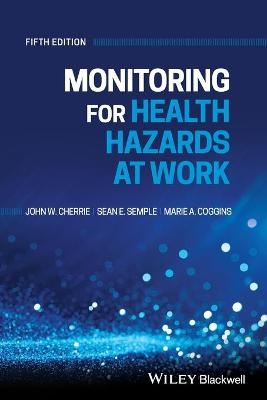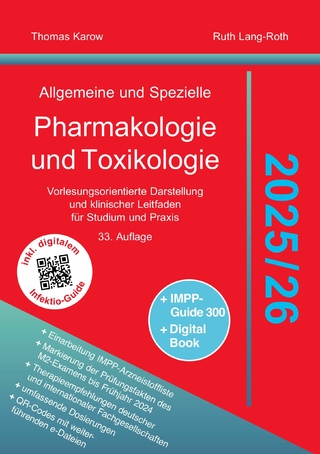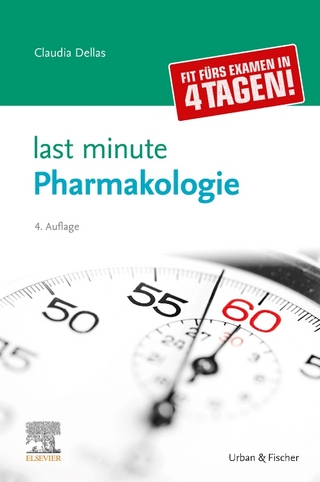
Monitoring for Health Hazards at Work
Wiley-Blackwell (Verlag)
978-1-119-61496-8 (ISBN)
The fifth edition features revised material throughout, and remains an essential resource for students and professionals in occupational hygiene, reflecting global standards and recent developments in monitoring equipment, modelling methods, exposure assessment, and legislation on workplace safety.
- Several new or substantially revised chapters cover topics such as human biomonitoring, exposure modelling, hazardous substances, physical agents, evaluating ventilation, PPE, and other control measures
- Updated sections discuss the equipment currently available, the importance of risk communication, assessing dermal and inadvertent ingestion exposures, and more
- Examines common workplace comfort issues such as noise, vibration, heat and cold, and lighting
- Offers practical advice on conducting and presenting risk assessments and reports
- Discusses the future of the development and application of hazard measurement equipment and methods
»Monitoring for Health Hazards at Work«, is required reading for students and professionals in occupational hygiene, environmental health and safety, occupational health and safety, and exposure science.
John Cherrie is Emeritus Professor of Human Health, Heriot Watt University, Edinburgh, UK. He is also a Principal Scientist at the Institute of Occupational Medicine, one of the longest-established independent occupational and environmental health research institutes in the world.
Sean Semple is Associate Professor, Faculty of Health Sciences and Sport, University of Stirling, UK. His research in human exposure science focuses on the health effects of indoor air pollution, occupational epidemiology, air quality measurement, and workplace inhalation hazards.
Marie Coggins is a Lecturer at the School of Physics and a member of the Centre for One Health at the Ryan Institute, National University of Ireland, Galway, Ireland. She is Academic Director for the NUI, Galway professional accredited BSc Environmental Health and Safety programme. The Exposure Science research group that she leads focuses on human exposure to occupational and environmental pollutants, including indoor air quality in energy efficient buildings.
List of Figures
Preface
Acknowledgements
Units and Abbreviations
Part 1 Introduction
Chapter 1 Occupational Hygiene and Risk Assessment
1.1 Introduction
1.2 Hazard and risk
1.3 Risk assessment
1.4 The stages of a risk assessment
1.4.1 Identify the hazard
1.4.2 Decide who might be affected and how
1.4.3 Evaluate the risks
1.4.4 Take preventative and protective measures
1.4.5 Record the significant findings
1.4.6 Review the assessment regularly and revise it if necessary
1.5 Who should carry out risk assessment?
1.6 References and further reading
Chapter 2 Identifying Hazards
2.1 Introduction
2.2 Identifying hazards
2.3 Example of hazard identification
2.4 Conclusions arising from a hazard assessment
2.5 References and further reading
Chapter 3 Exposure, Exposure Routes and Exposure Pathways
3.1 Introduction
3.2 Exposure routes
3.3 Exposure pathways
3.4 Measuring exposure
3.5 Biological monitoring
3.6 Exposure assessment: what the legislation requires
3.7 Conclusions
3.8 References and further reading
Chapter 4 The Exposure Context
4.1 Context for measurement
4.2 Sources of hazardous substances
4.3 Dispersion through the workroom
4.4 Receptor
4.5 Jobs and tasks
4.6 Conclusion
4.7 References and further reading
Chapter 5 Modelling Exposure
5.1 Introduction
5.2 Worst case models
5.3 Control banding and COSHH Essentials
5.4 Screening tools used for regulation of chemicals in Europe
5.5 The Advanced REACH Tool
5.6 Conclusions and prospects
5.7 References and further reading
Chapter 6 Why Measure?
6.1 Introduction
6.2 Reasons for undertaking monitoring
6.2.1 To support a risk assessment
6.2.2 To assess compliance with an OEL
6.2.3 To make a comparison with existing data
6.2.4 To provide baseline information on the exposure distributions within a plant
6.2.5 Supporting information for registration submissions under the REACH Regulations
6.2.6 Containment capability studies
6.2.7 To underpin a research study
6.3 References and further reading
Chapter 7 How to carry out a survey
7.1 Introduction
7.2 Planning the survey
7.3 Workplace monitoring
7.4 Monitoring strategies
7.5 Quality assurance and quality control
7.6 References and further reading
Chapter 8 Analysis of Measurement Results
8.1 Introduction
8.2 Dealing with variability in measurement results
8.3 Summary statistics and data presentation
8.4 Testing compliance
8.5 Other software tools to aid data analysis
8.6 References and further reading
Chapter 9 Introduction to Control
9.1 Introduction
9.2 Specific control measures
9.2.1 Elimination
9.2.2 Substitution
9.2.3 Total enclosure
9.2.4 Technological solutions
9.2.5 Segregation
9.2.6 Partial enclosure
9.2.7 Local ventilation
9.2.8 General ventilation
9.2.9 Personal protective equipment
9.3 The effectiveness of control measures
9.4 References and further reading
Chapter 10 The importance of good records and how to write a survey report
10.1 Record, educate and influence
10.2 Measurement records
10.3 Survey reports
10.3.1 General principles of writing a good report
10.3.2 Report structure
10.3.3 Common pitfalls and administrative points
10.4 References and further reading
Chapter 11 Risk Assessment
11.1 Introduction
11.2 Identify all hazardous substances or agents
11.3 Identify the likely levels of exposure
11.4 Identify all persons likely to be exposed
11.5 Assess whether the exposures are likely to cause harm
11.6 Consider elimination or substitution
11.7 Define additional control measures necessary to reduce the harm to acceptable levels
11.8 References and further reading
Chapter 12 Risk Communication
12.1 Introduction
12.2 Risk perception
12.3 Trust
12.4 Principles of good Risk Communication
12.4.1 Know your constraints before you start
12.4.2 Define the role of the communicator
12.4.3 Research your audience
12.4.4. Timing
12.5 The Presentation
12.6 Communicating risk
12.7 Quantitative risk assessment to aid risk communication
12.8 References and further reading
Part 2 Hazardous substances
Chapter 13 An introduction to hazardous substances
13.1 Introduction
13.2 The complexities of modern workplaces
13.3 The top five hazardous carcinogens
13.4 Substances of concern for the respiratory system
13.5 Pesticides, pharmaceuticals and other biologically active substances
13.6 Organic chemicals
13.7 Summary
13.8 References and further reading
Chapter 14 Dusts, Particles and Fibrous Aerosols
14.1 Introduction
14.2 Airborne particulate matter
14.3 Fibres
14.4 Measurement of airborne particulate and fibre concentrations
14.4.1 Filters
14.4.2 Filter holders and sampling heads
14.5 Measurement of flow rate
14.6 Pumps
14.7 Direct-reading aerosol monitors
14.8 Flow rate measurement using a rotameter or electronic flow calibrator by using the soap-bubble method
14.9 The measurement of inhalable airborne dust
14.9.1 Equipment required
14.9.2 Method
14.9.3 Calculations
14.9.4 Possible problems
14.10 The measurement of airborne respirable dust by using a cyclone sampler
14.10.1 Equipment required
14.10.2 Method
14.10.3 Calculations
14.10.4 Possible problems
14.11 The measurement of nanoparticles
14.12 The sampling and counting of airborne asbestos fibres
14.12.1 Equipment required for sampling
14.12.2 Method for sampling
14.12.3 Fibre counting and generating concentration data
14.12.4 Method of evaluation
14.12.5 Calculations
14.12.6 Possible problems
14.13 The choice of filter and filter holder to suit a specific dust, fume or mist
14.14 To trace the behaviour of a dust cloud by using a Tyndall beam
14.14.1 Equipment required
14.14.2 Method
14.15 References and further reading
Chapter 15 Gases and Vapours
15.1 Introduction
15.2 Collection devices
15.2.1 Adsorption methods
15.2.2 Adsorbent tubes
15.2.3 Passive samplers
15.2.4 Colorimetric detector tubes
15.3 Containers
15.4 Direct-reading instruments
15.5 To measure personal exposure to solvent vapours using an adsorbent tube
15.5.1 Equipment required
15.5.2 Method
15.5.3 Calculations
15.5.4 Example
15.6 References and further reading
Chapter 16 Bioaerosols
16.1 Introduction
16.2 Classification of microorganisms
16.3 Viruses
16.4 Bacteria
16.5 Moulds and yeasts
16.6 Allergens
16.7 Principles of containment
16.8 Monitoring bioaerosols
16.9 Measurement of endotoxins and allergens
16.10 Interpretation of sample results
16.11 References and further reading
Chapter 17 Dermal and Inadvertent Ingestion Exposure
17.1 Introduction
17.2 Occupations where dermal exposure is important
17.3 Local and systemic effects
17.4 How do we know if dermal exposure is an issue?
17.5 What do we measure?
17.6 Methods for dermal exposure measurement
17.7 Sampling strategy
17.8 Liquids and solids
17.9 Biomonitoring and modelling of dermal exposure
17.10 From exposure to uptake
17.11 Controlling dermal exposure
17.12 Inadvertent ingestion exposure
17.13 References and further reading
Chapter 18 Human Biomonitoring
18.1 Introduction
18.2 Selection of a suitable HBM method
18.3 Examples of HBM
18.4 Study protocols
18.5 Interpretation of HBM data
18.6 References and further reading
Part 3 Physical Agents
Chapter 19 An introduction to physical agents
19.1 Introduction
19.2 Physical agents in the workplace
19.3 Noise and vibration
19.4 Thermal environment
19.5 Ionising and non-ionising radiation
19.6 References and further reading
Chapter 20 Noise
20.1 Introduction
20.2 Frequency
20.3 Duration
20.4 Occupational exposure limits
20.5 Pressure and magnitude of pressure variation
20.6 Equipment available
20.7 Sound level meters and personal noise dosimeters
20.8 Personal noise dosimeters
20.9 Calibration
20.10 Collecting noise measurements
20.10.1 Using an SLM
20.10.2 Results
20.11 To measure workplace noise using a PND
20.11.1 Using a PND
20.11.2 Results
20.11.3 Possible complications
20.12 To measure the spectrum of a continuous noise by octave band analysis
20.12.1 Collecting a spectrum of a continuous noise by octave band analysis
20.12.2 Results
20.13 To determine the degree of noise exposure and the actions to take
20.14 References and further reading
Chapter 21 Vibration
21.1 Introduction
21.2 Vibration
21.3 Occupational exposure limits
21.4 Risk assessment
21.5 Measurements and measurement equipment
21.6 Hand-arm vibration measurement calculations
21.6.1 Reporting of vibration exposure data
21.7 Control of vibration
21.8 References and further reading
Chapter 22 Heat and Cold
22.1 Introduction
22.2 Heat stress
22.3 Measurement equipment
22.3.1 Dry bulb thermometers
22.3.2 Wet bulb thermometers
22.3.3 Air speed
22.3.4 Globe thermometers
22.3.5 Integrating WBGT instruments
22.4 Personal physiological monitoring
22.5 Measurement of the thermal environment
22.6 Predicted Heat Strain Index,
22.7 Risk assessment strategy
22.8 Thermal comfort
22.9 Cold environments
22.10 To calculate the wind chill factor
22.10.1 Procedure
22.11 References and further reading
Chapter 23 Lighting
23.1 Introduction
23.2 Lighting Standards
23.3 Equipment available
23.4 Calibration
23.5 To measure lighting
23.5.1 Aim
23.5.2 Equipment required
23.5.3 Method
23.5.4 Possible problems
23.5.5 Results and comparison with guidance
23.5.6 Reporting
23.6 Control
23.7 References and further reading
Chapter 24 Ionising Radiation
24.1 Introduction
24.2 Ionising radiation
24.3 Background radiation
24.4 Basic concepts and quantities
24.5 Types of radiation
24.6 Energy
24.7 Activity
24.8 Radiation dose units
24.8.1 Absorbed dose and dose equivalent
24.8.2 To calculate dose equivalent
24.8.3 Dose rate
24.9 Dose limits
24.10 Derived limits
24.11 Procedures to minimise occupational dose
24.12 Personal dosimetry and medical surveillance
24.12.1 Monitoring of ionising radiation in work areas
24.12.2 Personal monitoring for external dose
24.12.3 Film badge dosimeter
24.12.4 Thermoluminescent dosimeter
24.12.5 Direct-reading monitors
24.12.6 Air monitoring
24.13 References and further reading
Chapter 25 Non-Ionising Radiation
25.1 Introduction
25.2 Ultraviolet radiation
25.3 Visible and infrared radiation
25.4 Blue light
25.5 Microwaves, radiowaves and low frequency electric and magnetic fields
25.6 Lasers
25.7 References and further reading
Part 4 Control of hazards
Chapter 26 Assessing the effectiveness of exposure controls
26.1 Introduction
26.2 The effectiveness of control measures
26.2.1 Elimination and substitution
26.2.2 Ventilation and control measures at source
26.2.3 Personal protective equipment
26.3 Measuring exposure to assess the effectiveness of controls
26.4 References and further reading
Chapter 27 Assessing local ventilation control systems
27.1 Introduction
27.2 Air pressure
27.2.1 Static pressure
27.2.2 Velocity pressure
27.2.3 Total pressure
27.3 Measurement equipment
27.3.1 Pressure-measuring instruments
27.3.2 Air velocity measuring instruments
27.3.3 Barometric pressure instruments
27.4 Ventilation measurement records
27.5 Measurement of air flow in ducts
27.5.1 Aim
27.5.2 Equipment required
27.5.3 Method
27.5.4 Calculation
27.5.5 Example
27.5.6 Possible problems
27.6 Measurement of pressure in ventilation systems
27.6.1 Aim
27.6.2 Equipment required
27.6.3 Method
27.6.4 Results
27.6.6 Possible problems
27.7 To measure the face velocity on a booth, hood, or fume cupboard
27.7.1 Aim
27.7.2 Equipment required
27.7.3 Method
27.7.4 Results
27.7.6 Possible problems
27.8 References and further reading
Chapter 28 Personal Protective Equipment
28.1 Introduction
28.2 Components of an effective PPE programme
28.2.1 Assessment of risks and identification of where control is required
28.2.2 Implement all feasible controls
28.2.3 Identify who needs residual protection
28.2.4 Inform wearers of the consequences of exposure
28.2.5 Select PPE adequate to control residual exposure
28.2.6 Involve wearers in the PPE selection process
28.2.7 Match PPE to each individual wearer
28.2.8 Carry out objective fit-tests of RPE
28.2.9 Ensure that PPE does not exacerbate or create risks
28.2.10 Ensure PPE are mutually compatible
28.2.11 Train wearers in the correct use of their PPE
28.2.12 Supervise wearers to ensure correct use of PPE
28.2.13 Maintain PPE in efficient and hygienic condition
28.2.14 Inspect PPE to ensure it is correctly maintained
28.2.15 Provide suitable storage facilities for PPE
28.2.16 Record maintenance and inspection data
28.2.17 Monitor programme to ensure its continuing effectiveness
28.3 References and further reading
Part 5 The future
Chapter 29 Monitoring for hazards at work in the future
29.1 What the future holds for monitoring hazards at work
29.2 References and further reading
Appendix Survey checklists
Equipment Suppliers
Chemical Analytical Services
Index
| Erscheinungsdatum | 09.04.2021 |
|---|---|
| Verlagsort | Hoboken |
| Sprache | englisch |
| Maße | 152 x 229 mm |
| Gewicht | 672 g |
| Einbandart | kartoniert |
| Themenwelt | Medizin / Pharmazie ► Allgemeines / Lexika |
| Medizin / Pharmazie ► Medizinische Fachgebiete ► Arbeits- / Sozial- / Umweltmedizin | |
| Medizin / Pharmazie ► Medizinische Fachgebiete ► Begutachtung | |
| Studium ► 2. Studienabschnitt (Klinik) ► Pharmakologie / Toxikologie | |
| Naturwissenschaften ► Chemie | |
| Wirtschaft | |
| Schlagworte | Arbeitsschutz, Gesundheitsschutz • Arbeitssicherheit und -hygiene • Gefährdungsbeurteilungen |
| ISBN-10 | 1-119-61496-1 / 1119614961 |
| ISBN-13 | 978-1-119-61496-8 / 9781119614968 |
| Zustand | Neuware |
| Informationen gemäß Produktsicherheitsverordnung (GPSR) | |
| Haben Sie eine Frage zum Produkt? |
aus dem Bereich


